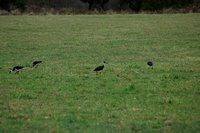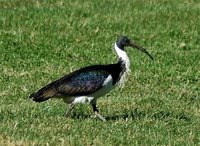 This winter has seen a lot of gentle rain falling over the Robertson area. One group of birds which have benefitted are the birds which hang out in the grazing lands around the district.
This winter has seen a lot of gentle rain falling over the Robertson area. One group of birds which have benefitted are the birds which hang out in the grazing lands around the district.Ibises (mostly the Straw-necked Ibis) have been seen regularly, this year, on the dairy farming properties along the Belmore Falls Road, just down the valley from my house. They also have been seen on the Hindmarsh Dairy, past the
 Robertson Show Grounds, and in East Kangaloon, (also on dairy farming properties).
Robertson Show Grounds, and in East Kangaloon, (also on dairy farming properties).This closer shot was taken in Canberra, several months ago.
These birds have long curved beaks and they spend hours at a time searching for grubs (in particular) in grassed paddocks, especially where cattle are to be found.
 They force their long beaks into the soft ground, in search of these grubs. Their hearing is apparently very sensitive allowing them to track the grubs.
They force their long beaks into the soft ground, in search of these grubs. Their hearing is apparently very sensitive allowing them to track the grubs.Other species are seen here too. I have seen just a few White Ibis on these paddocks. There is a White Ibis in this flock, and a White-faced Heron, (the grey bird standing upright).
 But last week there were 2 Cattle Egrets there. This is the first time I have seen Cattle Egrets in the Robertson area. I have seen them routinely in the much warmer Kangaroo Valley, just 10 Km away (directly), but an area with a "coastal climate", not a "mountain climate" as in Robertson. Unlike the Ibises, these particular Egrets hang out very closely with cattle, which disturb insects as they graze, and the Egrets pounce on the insects.
But last week there were 2 Cattle Egrets there. This is the first time I have seen Cattle Egrets in the Robertson area. I have seen them routinely in the much warmer Kangaroo Valley, just 10 Km away (directly), but an area with a "coastal climate", not a "mountain climate" as in Robertson. Unlike the Ibises, these particular Egrets hang out very closely with cattle, which disturb insects as they graze, and the Egrets pounce on the insects. Last week I also saw a Pacific Heron (White-necked Heron) in the same paddock as the Straw-necked Ibis flock. I was interested to note that this bird is considerable taller than those Ibises.
Last week I also saw a Pacific Heron (White-necked Heron) in the same paddock as the Straw-necked Ibis flock. I was interested to note that this bird is considerable taller than those Ibises.I know it has a more upright stance than the Ibis, but it has a very large wing-span. It is close to twice the size of the White-faced Heron - (the regular heron of the area). This bird is quite distinctive in flight, flapping very slowly, and with very dark wings, and a white chest and neck. But like most herons, it flies with its neck folded back into its body. Ibises fly with necks fully extended (plus their long beaks), so their flight profile is very different from this bird.

No comments:
Post a Comment